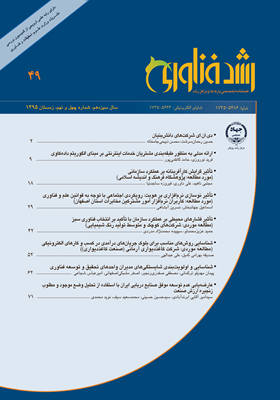شناسايي و اولويتبندي شايستگيهاي مديران واحدهاي تحقيق و توسعه فناوري
محورهای موضوعی : مديريت تحقيق و توسعهپیمان مهدیلو ترکمانی 1 , مصطفی صفدری رنجبر 2 , اصغر مشبکي اصفهانی 3 , امیرعباس شجاعی 4
1 - آزاد اسلامی واحد تهران جنوب
2 - دانشگاه علامه طباطبایی تهران
3 - دانشگاه تربيت مدرس
4 - دانشگاه آزاد اسلامی واحد تهران جنوب
چکیده مقاله :
امروزه نقش فناوري بهعنوان کليديترين عامل در خلق ثروت و ايجاد مزيت رقابتي پايدار در سطوح مختلف به اثبات رسيده است. با توجه به نقش واحدهاي تحقيق و توسعه در ارتقاي قابليتهاي فناورانه بنگاهها، مديريت اين واحدها بهشدت اهميت پيدا کرده است. بنابراين ارائه الگويي براي انتخاب مديران جديد يا توسعه قابليتهاي مديران فعلي اين واحدها ضروري مينمايد. در اين پژوهش مفاهيم شايستگي مديران و برخي چارچوبهاي پيشين مورد مطالعه قرار گرفته و در ادامه با برگزاري پانلي با حضور 12 نفر از خبرگان دانشگاه و صنعت نسبت به تأييد شايستگيهاي شناساييشده و دستهبندي آنها اقدام شد. سپس 32 شايستگي شناساييشده در سه دسته شايستگيهاي فردي و شخصيتي، شايستگيهاي مديريتي و رهبري و شايستگيهاي فني و تخصصي قرار گرفتند. در ادامه با دعوت از 62 نفر از مديران شاغل در اين واحدها و برگزاري جلسهاي به منظور معرفي و تشريح شايستگيهاي شناسايي شده، پرسشنامه پژوهش به آنها ارائه شد. سپس از طريق تحليل پرسشنامههاي دريافت شده از طريق آزمون فريدمن نسبت به اولويتبندي هر يک از شايستگيها و اولويتبندي دستههاي شناساييشده اقدام شد. نتايج پژوهش نشان ميدهد 3 شايستگي 1. کار تيمي، برقراري ارتباط و تسهيم دانش؛ 2. سازماندهي و هدايت تيمهاي تحقيقاتي و 3. ايجاد انگيزش و توانمندسازي متخصصين و کارکنان دانشي از اولويت بالاتري نسبت به ساير شايستگيهاي شناساييشده برخوردارند. همچنين در شايستگيهاي دستهبنديشده نيز شايستگيهاي فردي و شخصيتي نسبت به ساير دستهها از اولويت بالاتري برخوردار است.
Nowadays the role of technology as a key factor in creating wealth and permanent competitive advantages in various levels has been proven. With due attention to the role of R&D centers in promoting firms’ technological capabilities, the management of these centers are extremely important. So, it is essential to present a framework in order to selecting new managers or extending the capabilities of current managers of these centers. In current study the concept of manager competencies and some previous frameworks in this area have been studied. Then, through holding a panel with 12 academic and industrial experts, the identified competencies were confirmed. Afterwards, 32 competencies were categorized in 3 categories: 1. Individual and personality competencies, 2. Managerial and leadership competencies, and 3. Technical and professional competencies. Finally, through inviting 62 executive managers who work in these centers, and introducing and explaining about identified competencies, a questionnaire was given to them. Via analyzing the questionnaires with Friedman test, each of the competencies and categories were prioritized. The results show, three competencies including: 1. Team work, communication and knowledge sharing, 2. Organizing and conducting research teams, and 3. Motivating and empowering experts and knowledge workers have higher priority than other identified competencies. Also, in terms of categorized competencies, individual and personal competencies have higher priority than other categories.


